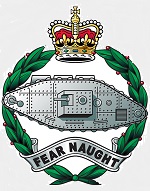-Corgi CC60603 British Cruiser Mk. VIII Centaur IV Medium Tank - Royal Marine Armoured Support Group, Sword Beach, Normandy, 1944 (1:50 Scale)
"After [El] Alamein, we never had a defeat."
- British Prime Minister Winston Churchill
 The Centaur Mk. I entered production in the autumn of 1942, and was armed with the 6-pounder gun. This was followed by the Mk. III with a 75mm gun and Mk. IV which mounted a 95mm howitzer. Early in 1943 most Centaur Mk. Is were converted to Mk. IIIs by changing the armament. The A27M Cromwell Mk. I entered production in January 1943, but only a few were produced before production switched to the Cromwell Mk. V equipped with a 75mm Q.F. Mk. V gun. By mid-1943 enough engines were produced to allow some of the older Centaurs to be converted to the Cromwell. These tanks -- mounting the 75mm gun -- were designated the Cromwell Mk. IV, and this became numerically the most important version. Most, if not all, Centaurs tanks were built with an internal track tension system which was accessed by two small dome covers located on the front plate just inboard of the lifting ring brackets. Domes were not present on the tanks built from the start as Cromwells; these tanks had an external track tension system which was adjusted by a large "hockey stick" steel bar, stowed on the side of the engine deck. On Cromwell conversions, there is evidence that some tanks were fitted with the external system. In this case the domes were welded in place or small armor patches were welded over the holes, and the "hockey stick" adjuster bar would be provided. Cromwell Mk. IV and Mk. V battle tanks, and Mk. VI close support tanks (95mm), started to be issued to the troops in October 1943 as they became available.
The Centaur Mk. I entered production in the autumn of 1942, and was armed with the 6-pounder gun. This was followed by the Mk. III with a 75mm gun and Mk. IV which mounted a 95mm howitzer. Early in 1943 most Centaur Mk. Is were converted to Mk. IIIs by changing the armament. The A27M Cromwell Mk. I entered production in January 1943, but only a few were produced before production switched to the Cromwell Mk. V equipped with a 75mm Q.F. Mk. V gun. By mid-1943 enough engines were produced to allow some of the older Centaurs to be converted to the Cromwell. These tanks -- mounting the 75mm gun -- were designated the Cromwell Mk. IV, and this became numerically the most important version. Most, if not all, Centaurs tanks were built with an internal track tension system which was accessed by two small dome covers located on the front plate just inboard of the lifting ring brackets. Domes were not present on the tanks built from the start as Cromwells; these tanks had an external track tension system which was adjusted by a large "hockey stick" steel bar, stowed on the side of the engine deck. On Cromwell conversions, there is evidence that some tanks were fitted with the external system. In this case the domes were welded in place or small armor patches were welded over the holes, and the "hockey stick" adjuster bar would be provided. Cromwell Mk. IV and Mk. V battle tanks, and Mk. VI close support tanks (95mm), started to be issued to the troops in October 1943 as they became available.
Armored thickness was 76mm on early Marks, but in 1944 some tanks received 25mm plates welded to the frontal armor, increasing the thickness to 101mm. Tanks with the 75mm became the Mk. VII, and those with the 95mm howitzer the Mk. VIII. The Cromwell, along with a few Centaur special purpose tanks, first saw action in the Normandy Campaign. Here it was at a disadvantage as it could not use it's superior speed and agility on treacherous beach terrain. This changed after the fighting moved to open country. Cromwell tanks made some spectacular advances in their pursuit of the Germans across northern France, Belgium and Holland.
Pictured here is a 1:50 scale replica of a British Cruiser Tank Mk. VIII Centaur IV medium tank that was attached to the Royal Marine Armored Support Group, operating on Sword Beach during the D-Day invasion, June 1944.
Sold Out!
Dimensions:
Length: 5-inches
Width: 2-inches
Release Date: June 2004
Historical Account: "D-Day" - Cromwells and Centaurs were generally armed with 75mm guns but had close support variants armed with 95mm guns. The only Centaurs to see action as gun tanks (as opposed to bulldozers and recovery vehicles) were 95mm variants (Centaur IVs) attached to the Royal Marine Armoured Support Group. 80 such Centaurs were to have formed the first wave of the D-Day assault, though not all made it ashore. Many special modifications were made: the bow machine gun was removed and plated over, mudguards were removed and their turrets were marked with degrees like a protractor to enable the gunfire to be directed. At the last minute, it was decided that the Centaurs would have to go ashore, so further water-proofing modifications were made. They were also provided with armoured sleds -- or porpoises -- to carry extra ammunition, since they were the first vehicles ashore, they could not be immediately re-supplied.





 British Cruiser Mk. VIII Centaur IV Medium Tank
British Cruiser Mk. VIII Centaur IV Medium Tank 









